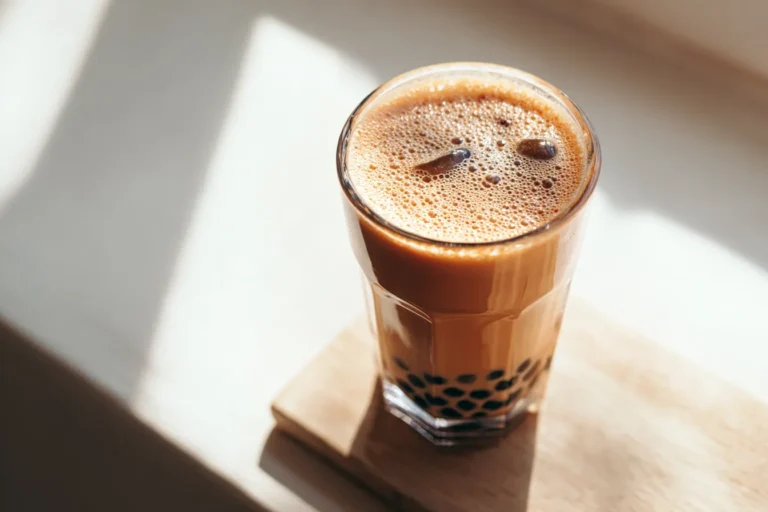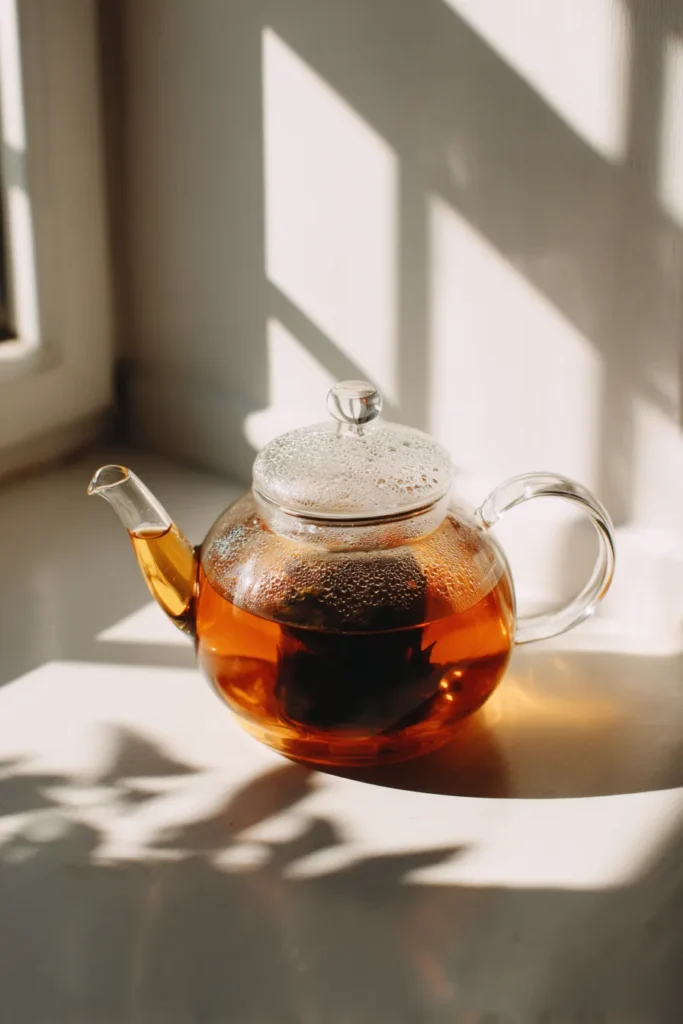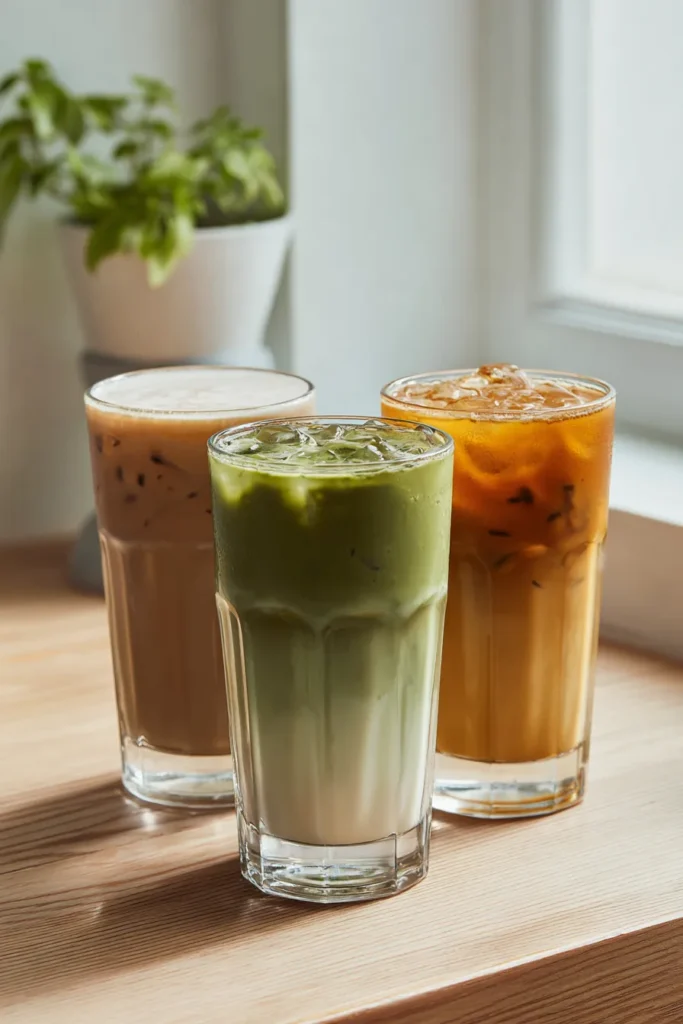I’ve spent countless afternoons sipping Hokkaido Milk Tea from boutique cafés in Tokyo to homemade versions in my kitchen and there’s one thing I consistently crave: that silk-smooth, dairy-forward indulgence. My perfected recipe brings café-level decadence right to your cup, using everyday ingredients for the classic, velvety experience.
- Silky texture from premium milk: Traditional Hokkaido Milk Tea gets its signature creaminess from rich, dairy-fed milk sourced from Hokkaido an island famous for its lush dairy farms.
- Gentle sweetness: I use light brown sugar to add just the right caramel-like note never too syrupy.
- Bold tea backbone: Steeping Assam or Darjeeling black tea gives the drink a robust yet smooth malty flavor.
- Completely customizable: Make it hot, over ice, or turn it into a boba dessert by adding pearls or jelly.
- Fast and satisfying: Ready in about 10 minutes just one pot, one steep, one delicious payoff.
- Dairy versatility: If you can’t find authentic Hokkaido milk, I’ve tested and matched whole milk plus cream to closely mimic that rich, creamy experience.
Jump to
Why You’ll Love Hokkaido Milk Tea
I didn’t fall in love with Hokkaido Milk Tea at first sip it was the second one that sealed it. That’s when the warmth, richness, and sweet malty depth all clicked. If you’re wondering whether this cozy Japanese classic is worth brewing at home, here’s why I keep making it week after week:
- Unmatched Creaminess: Thanks to the use of whole milk or Hokkaido-style milk, this tea has a velvety texture you won’t get from basic bubble tea.
- Balanced Sweetness: I use light brown sugar to avoid syrupy overload just enough to enhance the milk and tea.
- Robust Tea Flavor: Assam or Darjeeling black tea adds body and aroma that complements not competes with the cream.
- Quick to Make: Whether hot or iced, this drink takes less than 10 minutes, from steeping the tea to swirling in the milk. I save even more time by alternating it with a 2-ingredient coffee hack that’s just as satisfying when I want variety.
- Endlessly Customizable: Hot, iced, with boba, or even dairy-free this base Hokkaido Milk Tea recipe is your starting point for delicious variations.
- Great Alone or with Food: I pair mine with a slice of Japanese cheesecake or soft milk bread. Pure heaven.

Hokkaido Milk Tea: 6 Luxuriously Creamy Flavor Highlights
A creamy, smooth, and balanced tea drink made with rich Hokkaido milk, robust black tea, and subtle sweetness. Whether served hot or iced, this Hokkaido Milk Tea delivers café-style indulgence with simple ingredients and customizable options like boba or syrup.
- Total Time: 10 minutes
- Yield: 1 serving 1x
Ingredients
2 tbsp black tea (Assam or Darjeeling)
1½ cups water
1 cup Hokkaido milk (or ¾ cup whole milk + ¼ cup cream)
2 tsp light brown sugar (adjust to taste)
Cooked tapioca pearls
1 tsp brown sugar syrup
Dash of vanilla extract or vanilla bean
Cocoa dust or cinnamon for garnish
Instructions
Brew the Tea: Boil 1½ cups water, then steep 2 tbsp black tea for 3–5 minutes.
Sweeten While Warm: Stir in 2 tsp light brown sugar or syrup until fully dissolved.
Add Milk: Warm Hokkaido milk and stir into the tea (or combine whole milk + cream). Optional: gently simmer with tea for 1 minute—do not boil.
Serve Your Way:
Hot: Enjoy as is.
Iced: Let cool slightly, pour over ice.
Boba-style: Add tapioca pearls before pouring tea.
Notes
Add Ginger: Steep a slice of fresh ginger with your tea for a warming, spiced twist.
Skip the Sugar: Prefer it unsweetened? Just brew and add milk—still delicious.
Use Cold Milk: For iced versions, chilled milk helps cool it down quickly.
Add Mint: Drop in fresh mint leaves post-brew for a refreshing herbal layer.
Elevate with Cream: Use a touch more cream for ultra-luxurious texture.
- Prep Time: 5 minutes
- Cook Time: 5 minutes
- Category: Beverage
- Method: Stovetop
- Cuisine: Japanese / East Asian
Nutrition
- Serving Size: 1 glass (approx. 12 oz)
- Calories: ~190–230 per serving
- Sugar: 10–18g
- Sodium: 60–80mg
- Fat: 10g
- Saturated Fat: 6g
- Unsaturated Fat: 3g
- Trans Fat: 0g
- Carbohydrates: 18–28g
- Fiber: 0g
- Protein: 5g
- Cholesterol: 25mg
How Hokkaido Milk Tea Compares: Okinawa, Thai & Taiwanese Styles
Whenever someone asks me, “What is Hokkaido milk tea?”, I smile because that question usually means they’re about to discover one of the smoothest, most comforting drinks out there. But to appreciate it fully, it helps to understand how it stacks up against other popular milk tea styles.
| Style | Milk Type | Sweetener | Flavor Profile | Texture |
|---|---|---|---|---|
| Hokkaido | Hokkaido/whole milk | Light brown sugar | Cream-forward, slightly roasted, and silky smooth | Velvety |
| Okinawa | Whole milk | Kokuto (raw cane sugar) | Rich, molasses-like with deep caramel notes | Smooth |
| Thai Milk Tea | Evaporated/condensed | Condensed milk | Very sweet, slightly spicy from black tea blend | Syrupy |
| Taiwanese Boba | Creamer/whole milk | Syrup, honey | Balanced sweetness, more focused on toppings | Chewy + Light |
Why Hokkaido wins for me: It’s less cloying than Thai tea, more nuanced than Taiwanese boba tea, and lighter than Okinawa tea thanks to that clean, naturally creamy milk. If you’re just starting your tea journey, Hokkaido milk tea is the perfect intro.
Ingredients for Hokkaido Milk Tea
When I first tried making Hokkaido Milk Tea at home, I was nervous about nailing that perfect blend of creaminess and tea strength. Turns out, it’s surprisingly simple and flexible.
Here’s the version I keep coming back to:
Core Ingredients:
- 2 tbsp black tea (Assam for malty depth, or Darjeeling for a floral twist)
- 1½ cups water
- 1 cup Hokkaido milk (or substitute with ¾ cup whole milk + ¼ cup cream for richness)
- 2 tsp light brown sugar (adjust to taste)
Optional Add-ins:
- Tapioca pearls (pre-cooked, for boba-style texture)
- 1 tsp brown sugar syrup (for deeper sweetness)
- Vanilla bean or extract
- Cocoa dust or cinnamon (for topping)
The combo of strong brewed tea and luxuriously creamy milk is what gives this Hokkaido Milk Tea recipe its dreamy mouthfeel and balance. I always recommend starting simple, then customizing to your liking.

How to Make Hokkaido Milk Tea
I’ve tried dozens of variations, but this simple method consistently delivers a creamy, café-worthy cup. Whether you’re enjoying it hot or iced, this Hokkaido Milk Tea recipe is all about balance strong tea, silky milk, and just enough sweetness.
Step 1 – Brew the Tea
Bring 1½ cups of water to a boil, then steep 2 tbsp of black tea (Assam or Darjeeling) for 3–5 minutes. The longer you steep, the bolder the flavor just don’t overdo it or it turns bitter.
Step 2 – Sweeten While Warm
While the tea is still hot, stir in 2 tsp light brown sugar (or syrup) until it dissolves completely.
Step 3 – Add the Creamy Milk
Pour in 1 cup of warm Hokkaido milk (or whole milk + cream). Stir gently to combine. For extra richness, I sometimes simmer the milk with the tea for a minute don’t boil!
Step 4 – Serve Your Style
- Hot: Enjoy right away.
- Iced: Let the tea cool slightly, then pour over ice.
- Boba-style: Add cooked tapioca pearls to your glass before pouring in the tea.
This method makes the most of what Hokkaido Milk Tea is known for: that luxuriously smooth, mellow sweetness with a backbone of bold tea.
Helpful Tips for the Creamiest Cup
When I was fine-tuning my homemade Hokkaido Milk Tea, I realized it’s the little techniques that take it from just “milk tea” to a silky, café-level experience.
Here’s what works:
- Use quality loose-leaf tea: I recommend Assam for a malty richness, or Darjeeling if you like floral undertones. Don’t skimp on steep time 3 to 5 minutes is the sweet spot.
- Warm your milk—not boil: Heating the milk gently (without letting it scald) keeps it velvety. Overheating can dull the flavor and ruin the texture.
- Sweeten with brown sugar syrup: I make a quick 1:1 mix of brown sugar and water. It dissolves smoothly and adds that signature toasty sweetness Hokkaido Milk Tea is known for.
- Froth for texture: Use a milk frother or whisk to aerate the milk slightly it adds a luscious top layer and makes every sip feel extra indulgent.
- A pinch of salt: Just a pinch can balance sweetness and make the tea and milk flavors pop. It’s a subtle trick, but it works!

Customizations & Flavor Variations
One of my favorite things about Hokkaido Milk Tea is how forgiving and flexible it is. Once you’ve mastered the base, you can tailor it to fit your cravings or dietary needs.
Here’s how I switch it up:
- Decaf-Friendly: Swap in decaf Assam or a smooth rooibos if you want that warm tea comfort without the caffeine.
- Dairy-Free Dream: I’ve had great results with oat milk (for creaminess) or coconut milk (for a tropical twist). Just make sure to warm it gently like dairy.
- Matcha Fusion: Blend matcha with black tea to create a green-black tea hybrid unexpected, earthy, and energizing.
- Spiced Up: Add a dash of cinnamon, a whole clove, or a few cardamom pods to the steeping tea for a chai-inspired take.
- Protein Boost: Stir in unflavored or vanilla collagen powder or a scoop of protein for a functional tea-meets-snack upgrade. I’ve also enjoyed combining it with the purple peel weight loss blend as part of a natural wellness routine.
This isn’t just a tea it’s a base for countless delicious sips.
Toppings & Serving Suggestions
When I want to elevate my Hokkaido Milk Tea from an everyday sip to a boba-shop experience, I dive into toppings. They add texture, fun, and a little indulgence to each cup.
Here are my go-tos:
- Classic Tapioca Pearls: Cook them until soft and chewy, then add to your glass before pouring in the milk tea. They turn your drink into dessert.
- Grass Jelly: Smooth and subtly sweet, it pairs beautifully with the creamy base.
- Pudding or Custard Cubes: Yes, actual milk pudding! Soft, jiggly, and melts in your mouth so good with warm or iced tea.
- Aloe Vera Cubes: For a lighter, more refreshing version great with iced Hokkaido Milk Tea.
- Garnishes: Dust with cocoa powder, cinnamon, or add a split vanilla bean for a touch of elegance.
- Food Pairing: I love this tea with buttery Japanese milk bread or soft matcha cookies. It’s a match made for quiet mornings or cozy afternoons.
For something savory, I love enjoying it alongside this rich miso butter ramen for a comforting combo.

Random Facts About Hokkaido Milk Tea
Every time I brew a cup of Hokkaido Milk Tea, I remember why it feels so special it’s not just about the flavor, but the story behind it. Here are some fun facts that might surprise you:
- It’s named after Japan’s northernmost island, Hokkaido, famous for its high-quality dairy. The milk from this region is richer and creamier due to the cows’ grass-fed diet and cooler climate.
- Hokkaido produces over 50% of Japan’s milk, making it a natural inspiration for premium milk-based beverages.
- Royal Milk Tea is often used interchangeably with Hokkaido Milk Tea, but they’re slightly different—Royal typically uses more sugar and sometimes condensed milk.
- Assam tea is the base of choice because of its malty, full-bodied flavor that holds up beautifully against creamy milk.
- Powdered Hokkaido milk is a real product, used to mimic the region’s signature richness in recipes worldwide it’s often used in bubble tea shops outside of Japan.
These little details are why this isn’t just another milk tea it’s a rich, cultural sip of something truly unique.
Frequently Asked Questions
Whenever I mention Hokkaido Milk Tea to friends, I get a flurry of curious questions. Here are the most common ones and how I answer them from my own kitchen experience.
Q1: What is Hokkaido Milk Tea?
It’s a creamy Japanese milk tea made with rich Hokkaido milk (or a blend mimicking it) and bold black tea like Assam. The flavor is smooth, lightly sweet, and comforting like a cozy hug in a cup.
Q2: How does it differ from classic milk tea?
Hokkaido Milk Tea uses higher-fat milk (or a combo of whole milk and cream), often sweetened with brown sugar for warmth, giving it a richer and silkier profile than standard versions.
Q3: Is Hokkaido Milk Tea healthy?
It depends on how it’s made! Homemade versions can be relatively balanced especially if you use less sugar and skip the boba. It also offers antioxidants from the tea and calcium from the milk.
Q4: Can it be made dairy-free?
Absolutely. I love using oat milk for a nutty creaminess or coconut milk for a tropical note. You’ll still get that luxurious feel without the dairy.
Q5: Why did my tea taste bland?
It might need a stronger steep or better tea. Use quality loose-leaf tea, steep for a full 3–5 minutes, and don’t add too much milk aim for balance.
Q6: Can I make it iced with toppings?
Yes! Let the tea cool, add ice, and drop in boba, jelly, or pudding. It’s one of my favorite ways to enjoy it during warmer months.
Storage & Maintenance
When I make a batch of Hokkaido Milk Tea, I sometimes save half for later especially if I’m prepping for guests or just craving a cold version for the next day. Here’s how I keep it tasting fresh:
- Best Fresh: It’s at its creamiest and most flavorful right after brewing. If you can, enjoy it within the first hour.
- Refrigeration Tips: If storing, keep the sweetened tea and milk separate. Combine them just before drinking for the smoothest texture.
- Shelf Life: Stored in the fridge, it lasts up to 2 days. Make sure it’s in an airtight jar or bottle.
- Reheating: Gently warm on the stovetop or microwave in short bursts. Stir well to prevent separation.
- Cleanup Reminder: Clean your pot or frother right away the milk can stick and be hard to wash once it sets.
I always keep a mason jar of the tea base ready to go it saves time and makes my mornings (or snack breaks) a little sweeter. For a hydration boost before your tea, I sometimes pair it with this pink salt morning tonic to start the day refreshed.
Follow us on Medium and Pinterest for easy daily tips on natural weight loss, simple recipes like Purple Peel and Zepbound-inspired blends, and Pot Recipes you’ll want to share.
Final Thoughts
If you’ve never tried Hokkaido Milk Tea, let this be your gentle nudge. It’s more than a drink it’s a moment. Rich without being heavy, sweet but not syrupy, and endlessly customizable whether you like it hot, iced, or with boba.
For me, it started with a craving for something cozy on a cold morning. Now it’s become a little ritual: brewing the tea, steaming the milk, and taking that first silky sip. Whether you’re trying to recreate your favorite café flavor or just want a new twist on tea, this recipe brings warmth and calm in every cup.
It pairs beautifully with Zepbound-inspired recipes when I’m focused on clean, gentle wellness goals.
So the next time someone asks, “What is Hokkaido Milk Tea?” you’ll not only know you’ll have your own perfect version ready to share.





